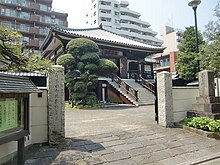Renkō-ji
| Renkō-ji | |
|---|---|
 | |
| Location | |
| Country | Japan |
| Website | |
| None | |

Renkōji Temple (蓮光寺, Renkōji) is a Buddhist temple in Tokyo, Japan. It is assumed to be the purported location of the ashes of Netaji Subhas Chandra Bose, Indian freedom-fighter, which have been preserved since September 18, 1945.[1]
The small, well-preserved temple was established in 1594 inspired by the God of Wealth and Happiness. It belongs to the Nichiren sect of Buddhism that believes that human salvation lies only in the Lotus Sutra.
Netaji Subhas Chandra Bose
The ashes of Subhas Chandra Bose came to the temple for the purpose of a funeral ceremony but Rev. Mochizuki, father of the present chief monk, agreed to keep them in safe custody. Bose's funeral was held at 8:00 p.m. on September 18, 1945.[2] Netaji’s associates observe his death anniversary on August 18 at the temple every year. Over the years, several Indian officials have visited Renkoji to pay their respects to Subhas Chandra Bose: Prime Minister Jawaharlal Nehru was the first dignitary to visit the site in October 1957.[3] President Dr. Rajendra Prasad followed him a year later. Indira Gandhi visited in 1969.[4] Atal Bihari Vajpayee, former Prime Minister of India, first visited the temple during his term as Foreign Minister. He later visited it during his official visit to Japan on December 9, 2001. In 2000, the then Indian Minister of External Affairs, Jaswant Singh, visited the temple in November.
The ashes of Netaji are placed in a small golden pagoda.[2]
Controversy
The Justice Mukherjee Commission of Inquiry submitted its report to the Indian Government on November 8, 2005. The report was tabled in Parliament on May 17, 2006. The probe said in its report that as Bose did not die in the plane crash, and that the ashes at the Renkoji Temple are not his. However, the Indian Government rejected the findings of the Commission, though no reasons were cited.
See also
- Mission Netaji
- For an explanation of terms concerning Japanese Buddhism, Japanese Buddhist art, and Japanese Buddhist temple architecture, see the Glossary of Japanese Buddhism.
References
- ^ http://www.dnaindia.com/report.asp?NewsID=1083668 DNA India news article, retrieved on 20 August, 2007
- ^ a b "【ボースの遺骨を守って】もう一つの日印交流(1)敗戦下の葬儀". Sankeishinbun. 2009-09-14. Retrieved 2009-10-17.
- ^ "【ボースの遺骨を守って】もう一つの日印交流(2)ネールの礼状". Sankeishinbun. 2009-09-21. Retrieved 2009-10-18.
- ^ "【ボースの遺骨を守って】もう一つの日印交流(3)「日印協会」の変遷". Sankeishinbun. 2009-09-28. Retrieved 2009-10-17.

